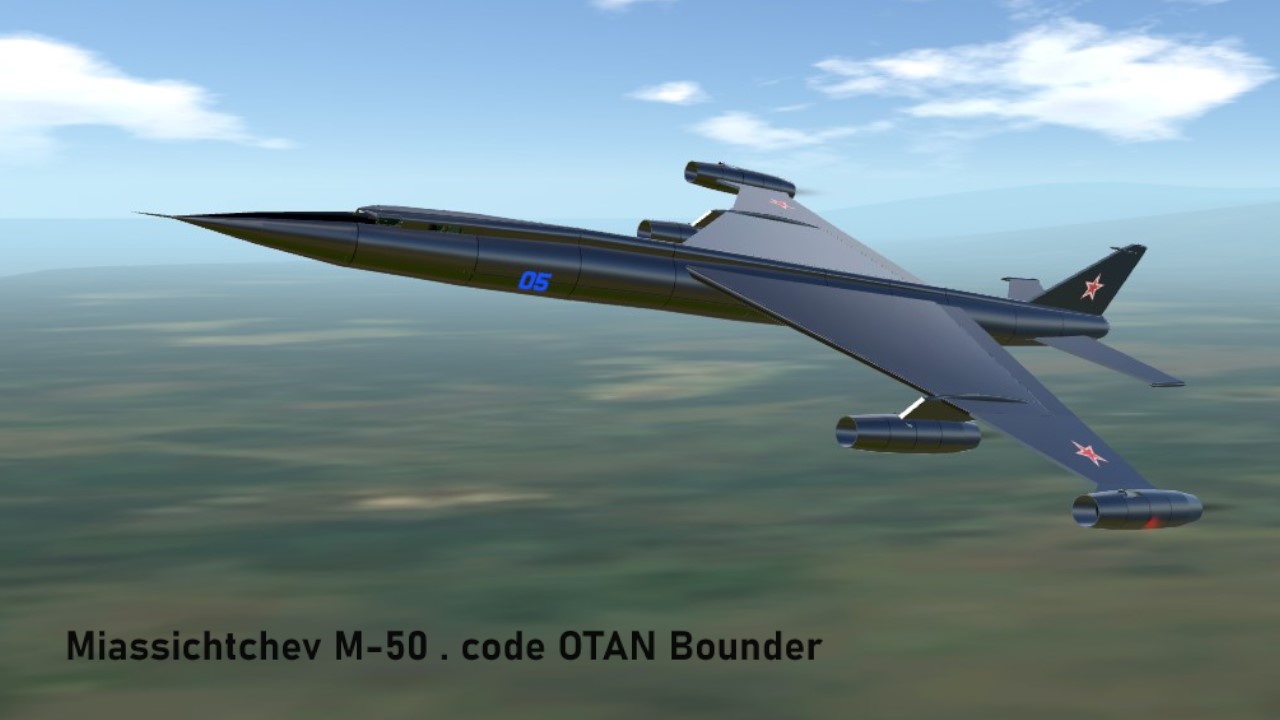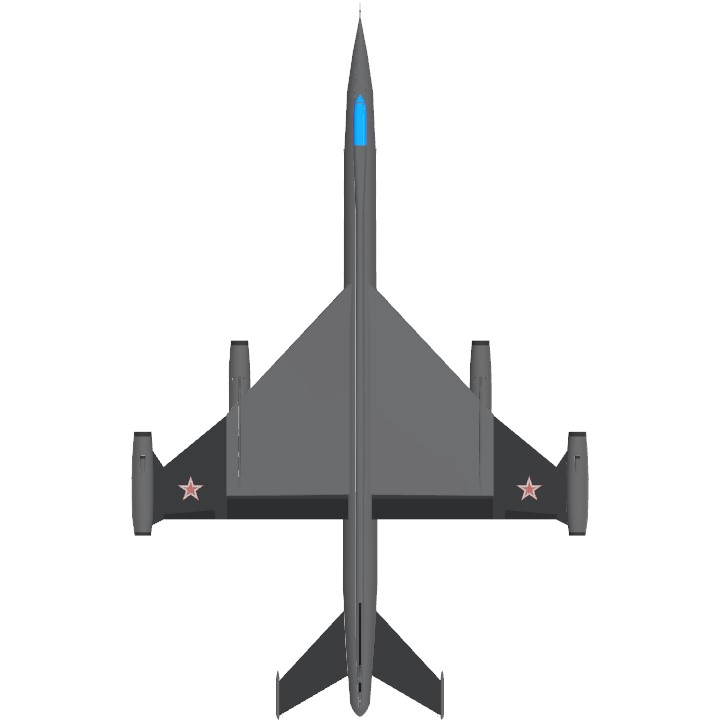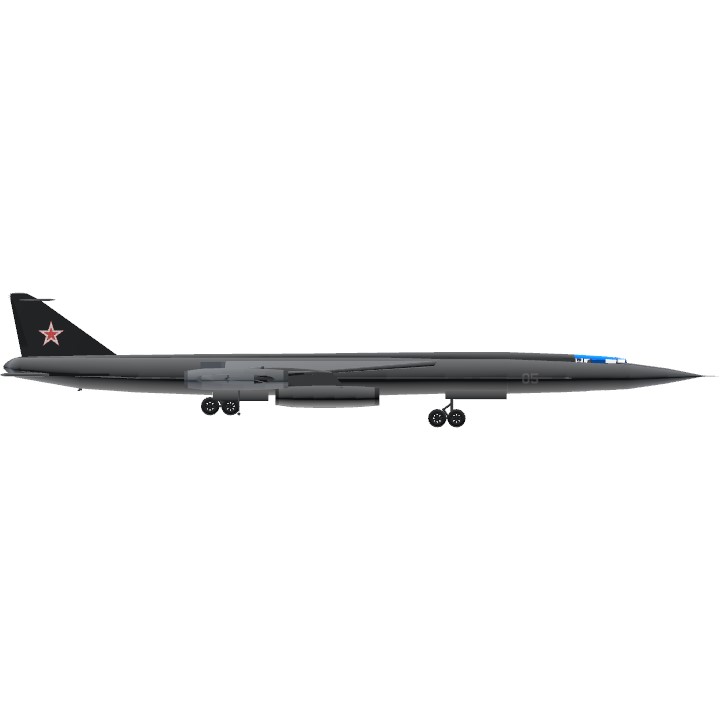( English version at the bottom of the page )
Un peu d'histoire pour mieux connaitre cet appareil qui fit si peur à l'occident en 1961 .
Le Miassichtchev M-50 ( code OTAN : Bounder) est un prototype de bombardier stratégique supersonique soviétique . Le M-50 effectue son premier vol le 27 octobre 1959.
Deux appareils construits . Le M-50 cesse les vols d'essais dans les années 1960 . Une seconde version, le M-52, est étudiée .
La construction de l'appareil débute en 1958 et n'est jamais achevée . La version n°2 de l' appareil est exposé au musée de Monino .
Cette cellule n'a jamais volée .
Le prototype M-50A sortit d'usine en juillet 1958. Il aurait dû être propulsé par des Zubets RD-16-17 de 18490 kgp,
mais le développement de ceux-ci avait pris du retard. Il fut donc doté de 4 Dobrynine VD-7BA (9500 kgp à sec, ne dispose pas de la PC).
Le carburant n'était pas disposé dans les ailes d'ailleurs trop minces, mais dans le fuselage qui en fait était un énorme réservoir.
Le train d'atterrissage, monotrace et bicycle, était similaire à celui du M-4 et actionné hydrauliquement. Les réservoirs de carburant
étaient vidés de façon à rééquilibrer le centre de gravité, ce qui était une gageure à l'époque.
Les 2 membres d'équipage étaient placés en tandem dans un cockpit pressurisé et disposaient de combinaisons spéciales pour le vol
à haute altitude (14000 mètres). L'avionique prévue pour la navigation et le bombardement était entièrement automatisée, mais on
ignore si elle fut effectivement installée. Le pilote automatique, par exemple, était très en avance sur son temps, même par rapport
à ses équivalents américains. Les pilotes disposaient de commandes de vol électriques, au moins partielles, quelques décennies avant
leur emploi généralisé. Des manches latéraux étaient même prévus. Compte tenu de l'aspect très cabré de l'appareil, un nez basculant
fut également envisagé, bien avant le Concorde. Il emportait dans la soute un missile de croisière M-61.
Cependant, Kroutchev croyait davantage aux missiles intercontinentaux et considérait les bombardiers dépassés. Le M-50 fut abandonné
en conséquence dès décembre 1960, et le M-52 ferraillé alors qu'il était presque fini. Lorsqu'il apparut au public le 9 juillet 1961, il
fit forte impression sur les Occidentaux en laissant sur place les 2 MiG-21 d'escorte. Persuadés d'avoir affaire à un bombardier très
en avance sur son temps, ils le surnommèrent "Bounder". Ce qu'ils ne savaient pas, c'est que ce 19e vol du M-50 était son dernier.
Cet unique exemplaire avait porté divers numéros (022, 023, 05 et 12) .
C'est ma cinquième version de cet avion ( un de mes avions préféré , vous vous en doutez ) . Une photo avec les quatres premières version vous
permettra de mesurer les progrès parcourus .
Décoration du prototype numéro 05 ( Le prototype a volé avec plusieurs numéros ) .
Le cockpit a été imaginé d'après d'autres appareils russe de l'époque . Je n'ai pas réussi malgré des semaines de recherche à trouver
des photos du poste de pilotage .
Nouveauté sur cet version : poste de pilotage , opérateur radar visible , cellule , trappes et logements du train , ailes , train d'atterissage et balancelles , nacelles récateurs , décoration .
Décollage avec volets à fond et un cran de trim , gaz à 40% et train avant verrouillé . Manche à fond en arrière à partir de 200 Mph jusqu'au décollage . Rentrer le train
et les volets rapidement , monter les gaz et régler trim pendant la montée en altitude . Corriger le vol en palier avec le trim .
Le M-50 Bounder n'a jamais atteint les performances prévues .
Le modèle que je vous présente respecte les perfomances atteintes réellement atteintes pendant les vols d'essais , environ 800 Mph .
Commande :
-Touche 1 : réacteurs gauche exterieur .
-Touche 2 : réacteurs gauche interieur .
-Touche 3 : réacteurs droit interieur .
-Touche 4 : réacteurs gauche exterieur .
-Touche 5 : feux position .
-Touche 6 : feux atterrissage .
-touche 7 : Parachute de queue .
-Touche 8 : verrouillage train avant .
-Touche Vtol : volets .
-Trim : trim .
C'est ma première création sur plan .
Screens fait la map " Olyoma - Thunder Bay " crée par Annedzsrue .
English version :
A little history to better understand this device which so frightened the West in 1961.
The Miasishchev M-50 (NATO code: Bounder) is a prototype Soviet supersonic strategic bomber. The M-50 made its first flight on October 27, 1959.
Two devices built. The M-50 ceased test flights in the 1960s. A second version, the M-52, is being studied.
Construction of the device began in 1958 and was never completed. Version no. 2 of the device is on display at the Monino museum.
This cell has never flown.
The M-50A prototype left the factory in July 1958. It should have been powered by Zubets RD-16-17 of 18,490 kgp,
but their development had lagged behind. It was therefore equipped with 4 Dobrynine VD-7BA (9500 kgp dry, does not have the PC).
The fuel was not placed in the wings, which were too thin, but in the fuselage which was in fact a huge tank.
The undercarriage, single track and bicycle, was similar to that of the M-4 and operated hydraulically. Fuel tanks
were emptied in order to rebalance the center of gravity, which was a challenge at the time.
The 2 crew members were placed in tandem in a pressurized cockpit and had special suits for the flight
at high altitude (14,000 meters). The avionics provided for navigation and bombardment were fully automated, but we
unknown if it was actually installed. Autopilot, for example, was way ahead of its time, even compared to
to its American equivalents. Pilots had at least partial fly-by-wire flight controls a few decades before
their widespread use. Side sleeves were even planned. Given the very nose-up appearance of the aircraft, a tilting nose
was also considered, well before Concorde. It carried an M-61 cruise missile in the hold.
However, Kruchev believed more in intercontinental missiles and considered bombers outdated. The M-50 was abandoned
as a result from December 1960, and the M-52 scrapped when it was almost finished. When he appeared to the public on July 9, 1961, he
made a strong impression on the Westerners by leaving the 2 escort MiG-21s behind. Convinced that they were dealing with a very bomber
ahead of his time, they nicknamed him "Bounder". What they didn't know was that this 19th flight of the M-50 was its last.
This unique copy had various numbers (022, 023, 05 and 12).
This is my fifth version of this plane (one of my favorite planes, as you can imagine). A photo with the first four versions for you
will allow us to measure progress.
Decoration of prototype number 05 (The prototype flew with several numbers).
The cockpit was designed after other Russian aircraft of the time. I haven't been able to find it despite weeks of searching.
photos of the cockpit.
New on this version: cockpit, visible radar operator, cell, hatches and gear housings, wings, landing gear and swings, recator nacelles, decoration.
Takeoff with full flaps and one trim notch, throttle at 40% and nose gear locked. Stick fully back from 200 Mph until takeoff. Return the train
and flaps quickly, increase throttle and adjust trim while climbing in altitude. Correct level flight with trim.
The M-50 Bounder never achieved its intended performance.
The model that I am presenting to you respects the performances actually achieved during the test flights, approximately 800 Mph.
Order :
-Key 1: left exterior reactors.
-Key 2: interior left reactors.
-Key 3: interior right reactors.
-Key 4: left exterior reactors.
-Key 5: position lights.
-Key 6: landing lights.
-key 7: Tail parachute.
-Key 8: front axle lock.
-Vtol button: shutters.
-Trim: trim.
This is my first creation on plan .
Screens makes the map "Olyoma - Thunder Bay" created by Annedzsrue.
Specifications
General Characteristics
- Predecessor Miassichtchev M50 Bounder
- Created On Windows
- Wingspan 64.1ft (19.5m)
- Length 100.9ft (30.8m)
- Height 18.9ft (5.8m)
- Empty Weight N/A
- Loaded Weight 65,307lbs (29,623kg)
Performance
- Power/Weight Ratio 5.54
- Wing Loading 105.0lbs/ft2 (512.9kg/m2)
- Wing Area 621.7ft2 (57.8m2)
- Drag Points 14926
Parts
- Number of Parts 485
- Control Surfaces 7
- Performance Cost 2,439










@XEPOH , Thanks for your upvote .
@UseGooglePlay , thank you for your upvote .
@ChiChiWerx , thanks for your upovte .
@Bryan5 , thanks for your upvote .
@Trainzo Noes plroblems
@Christiant2 , thanks you .
@Trainzo Looks cool!
@IQinventory , Like me .
@Trainzo exactly what i love
@IQinventory , Or projects that never got off the drawing board .
@IQinventory , You will see, I discovered a lot of rare planes there .
@Trainzo thanks dont have any in mind right know .
but if wanted ill let you know .
and ill check out this site
@IQinventory , Apart from the secret project site, I'll give you a link.
Give me a list of planes, I have books, I'll see if I have any plans .
https://www.secretprojects.co.uk/
@Trainzo i saw a list of soviet prtotype aircratf a while ago i couldnt find any of them .
is there like website or something i can visit
@IQinventory , Yes, which plane are you looking for ?
@Trainzo oh so do i . but the blueprints are hard to find
@IQinventory , thanks for your upvote and your comment . It's nice .
@IQinventory , These are the ones I prefer .
The way make the cockpit is insane.
very welldone
great. i was gonna make it . but i was too busy.
i experament planes .
@Christiant2 , thanks for your upvote .
@AluminiumFX , thanks for your upvote , my friend .
@Trainzo 👍
@Superliner350 , @AluminiumFX , thanks for yours upvotes .
@HanakoSan , @CR929thenewSPplayer , thanks for yours upvotes .